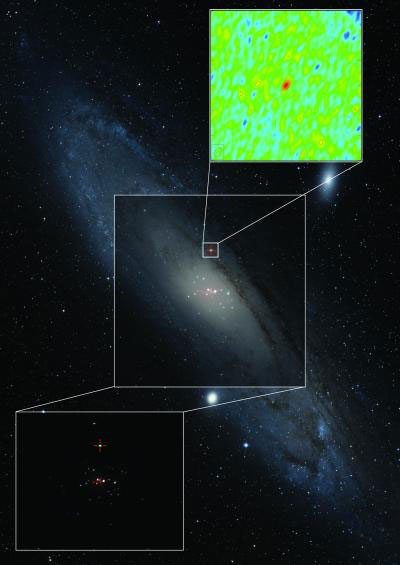| Dec 12, 2012 |
Astronomers discover 'missing link' of black holes
|
|
(Nanowerk News) The discovery of a bingeing black hole that is expelling powerful beams of material has shed new light on some of the brightest X-ray sources seen in other galaxies, according to new research led by Durham University.
|
|
Using Earth-orbiting X-ray telescopes, including NASA's Swift and the European Space Agency's XMM-Newton satellites, a large international team of astronomers watched as the X-ray emission from the black hole in our nearest neighbouring galaxy, Andromeda – found more than 2 million light years away – brightened and faded over the course of six months.
|
|
The study, published in the prestigious scientific journal Nature, shows what happens when black holes feast rapidly on the material stripped from a companion star.
|
 |
| A new X-ray source (lower left and detailed in "DUBlack hole missing link Detail 1) detected in the nearby galaxy M31 ("DUBlack hole missing link Overview") was discovered to be associated with an extremely compact radio source (upper right and detailed in "DUBlack hole missing link Detail 2). The coupled X-ray and radio emission point to a stellar-mass black hole accreting above its maximum luminosity threshold.
|
|
This is the first time that radio jets have been detected from a stellar-mass black hole outside our own Milky Way galaxy. It is the second Ultraluminous X-Ray source (ULX) to have been spotted in Andromeda in the past two years.
|
|
X-ray telescopes have shown how many nearby galaxies host ULXs, which can be bright enough to outshine an entire galaxy in X-rays.
|
|
Astronomers have spent years debating whether these are black holes just a few times the mass of the Sun which are gorging themselves on gas from an orbiting star, or whether they are more massive black holes eating more sedately.
|
|
Lead author Dr Matthew Middleton, who led the latest research while at Durham University, said the findings helped solve this debate.
|
|
Dr Middleton, now based at the University of Amsterdam, said: "The black hole we observed in Andromeda is the missing link.
|
|
"Our observations tell us that this ultraluminous X-ray source – and by extension, many others – is just a run-of-the-mill black hole, only about ten times the mass of the Sun, that is swallowing material as fast as it can."
|
|
Dr Middleton added: "We watched a black hole go from nibbling daintily at an appetiser to bingeing on the main course, and then gradually slowing down over dessert."
|
|
Black holes in our own Milky Way galaxy are very rarely seen to binge, but when they do, they also launch very powerful beams of material called jets, which are blasted outwards at close to the speed of light, and can be tracked using sensitive radio telescopes.
|
|
The team trained the National Science Foundation's Karl G. Jansky Very Large Array on the black hole, and saw extremely bright radio wave emission that dropped by a half in just 30 minutes.
|
|
"Discovering these radio waves from an ultraluminous X-ray source is the smoking gun, a dead giveaway that these are just normal, everyday black holes," said co-author
|
|
Dr James Miller-Jones, of the Curtin University node of the International Centre for Radio Astronomy Research in Perth, Australia.
|
|
"This tells us that the region producing radio waves is extremely small in size, no further across than the distance between Jupiter and the Sun." Despite the large distance to Andromeda, the absence of dust and gas in that direction allows an unhindered view of the feast, giving scientists key new insights into how jets are produced by a binging black hole.
|
|
This finding was confirmed by zooming in using the world's most eagle-eyed radio telescope, the Very Long Baseline Array.
|
|
Co-author Dr Tim Roberts, in the Department of Physics, Durham University, said: "We've had the ability to study ULXs for more than a decade, but it's only because we had the good fortune that this object appeared in our local neighbourhood that we've been able to make these breakthrough observations and demonstrate this is a relatively small black hole."
|

